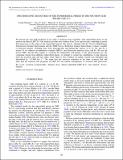SPECTROSCOPIC SIGNATURES OF THE SUPERORBITAL PERIOD IN THE NEUTRON STAR BINARY LMC X-4
Author(s)
Neilsen, Joseph M. G.; Lee, Julia C.; Nowak, Michael A.; Dennerl, Konrad; Vrtilek, Saeqa Dil
DownloadNeilsen-2009-SPECTROSCOPIC SIGNAT.pdf (318.9Kb)
PUBLISHER_POLICY
Publisher Policy
Article is made available in accordance with the publisher's policy and may be subject to US copyright law. Please refer to the publisher's site for terms of use.
Terms of use
Metadata
Show full item recordAbstract
We present the first high-resolution X-ray study of emission line variability with superorbital phase in the neutron star binary LMC X-4. Our analysis provides new evidence from X-ray spectroscopy confirming accretion disk precession as the origin of the superorbital period. The spectra, obtained with the Chandra High-Energy Transmission Grating Spectrometer and the XMM-Newton Reflection Grating Spectrometer, contain a number of emission features, including lines from hydrogen-like and helium-like species of N, O, Ne, and Fe, a narrow O VII radiative recombination continua (RRCs), and fluorescent emission from cold Fe. We use the narrow RRC and the Heα triplets to constrain the temperature and density of the (photoionized) gas. By comparing spectra from different superorbital phases, we attempt to isolate the contributions to line emission from the accretion disk and the stellar wind. There is also evidence for highly ionized iron redshifted and blueshifted by ~25,000 km s[superscript –1]. We argue that this emission originates in the inner accretion disk and show that the emission line properties in LMC X-4 are natural consequences of accretion disk precession.
Date issued
2009-05Department
MIT Kavli Institute for Astrophysics and Space ResearchJournal
Astrophysical Journal
Publisher
Institute of Physics/American Astronomical Society
Citation
Neilsen, Joseph, Julia C. Lee, Michael A. Nowak, Konrad Dennerl, and Saeqa Dil Vrtilek. “SPECTROSCOPIC SIGNATURES OF THE SUPERORBITAL PERIOD IN THE NEUTRON STAR BINARY LMC X-4.” The Astrophysical Journal 696, no. 1 (April 15, 2009): 182–191. © 2009 American Astronomical Society.
Version: Final published version
ISSN
0004-637X
1538-4357